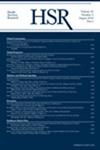Increasing expenditures on home- and community-based services: Do home care workers benefit?
Abstract
Objective
To examine the association of Medicaid home- and community-based services (HCBS) expenditures on the home care workforce.
Data Sources/Study Setting
We use two national, secondary data sources from 2008 to 2019: state-level Medicaid HCBS expenditures and the American Community Survey, in which we identify direct care workers in the home (i.e., home care workers), defined as nursing, psychiatric, and home health aides or personal care aides working in home health care services, individual and family services, and private households.
Study Design
Our key explanatory variable is HCBS expenditures per state per year. To estimate the association between changes in Medicaid HCBS expenditures and the workforce size, hourly wages and hours worked, we use negative binomial, linear, and generalized ordered logit regression, respectively. All models include demographic and socioeconomic characteristics, the number of potential HCBS beneficiaries (individuals with a disability and income under the federal maximum income eligibility limits), indicators for minimum wage and/or overtime protections for direct care workers, wage pass-through policies, and state and year fixed effects.
Data Collection/Extraction Methods
We exclude states with incomplete reporting of expenditures.
Principal Findings
States' HCBS expenditures increased between 2008 and 2019 after adjusting for inflation and the number of potential HCBS beneficiaries. Yet, home care workers' wages remained stagnant at $11–12/h. We find no association between changes in Medicaid HCBS expenditures and wages. For every additional $1 million in Medicaid HCBS expenditures, the expected number of workers increases by 1.2 and the probability of working overtime increased (0.0015% points; p < 0.05). Results are largely robust under multiple sensitivity analyses.
Conclusions
We find no evidence of a statistically significant relationship between changes in state-level changes in Medicaid HCBS expenditures and worker wages but do find a significant, but small, association with hours worked and workforce size.

 求助内容:
求助内容: 应助结果提醒方式:
应助结果提醒方式:


